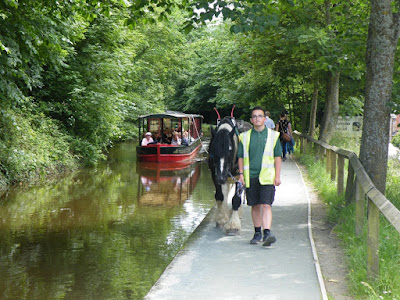So first here are some highlights of the few days coming back along the Llangollen:
Here is Ian at the tiller coming to the end of the crossing of the Pontcysyllte Aqueduct over the River Dee. Unlike going the other way it was not a weekend and the clouds were threatening rain so there were fewer pedestrians along the towpath.
But the sun did come out and you can see our shadow here projected down onto the grasslands next to the River Dee far below.
And then back over the Chirk Aqueduct too, this time following another boat across.
At the end of the Chirk Aqueduct we passed back into England as this sign shows. However this was not the end of Wales as the canal pops back a few times as it carries on East.
As we cruised through Chirk we passed a number of gardens with unusual displays fronting the canal. Several of them had a table set out with tea things and this one has the door to a 'hobbit hole' painted in green to the left of the tree.
If you want a quiet cruise then the Llangollen is not the place to go. Here we are in a convoy of other boats (mainly hire boats) which made life difficult for those going the other way. While the Western end of the canal was very busy, we found far fewer boats from Ellesmere onwards.
On Thursday we enjoyed a walk round Cole Mere in the afternoon. The Meres round here are lakes left over from the last Ice Age. This one's claim to fame is that it is the only place in the UK where you will find the Least Water Lily - no, we'd never heard of it either, but we have now seen it.
On Friday afternoon we did a different walk around Whixall Moss which is an area of raised peat bog again left over from the Ice Age. It pays to follow the signposts here. As you can see, wandering off the path could land you in the bog. The Moss has quite a history of peat cutting and of decoy bombing sites in the war. We found the scenery and the history fascinating.
Last weekend our son, David, came to join us. Here you can see David next to Helen and Leo at the top of the Grindley Brook locks.
On a walk up some low Cheshire hills we passed a field with this miniscule pony who came running over to say hello.
We did admire David's lurid red trainers though they do seem to clash with the rear deck paint.
Now here is a rare sight. You can see Ian operating the lift bridge at Wrenbury. Normally Ian does the driving through the bridges and Helen is the one with the expertise to operate them. With David aboard, Ian decided to have some fun learning to work the bridges.
The Mallards round here are really adventurous. Not only do they dive underwater for food (something the books say they don't do), but they also seem to like playing in the lock bywashes like here.
Here's a close up of a large duckling in the bywash, eating the weed and holding on with its feet. When the family had finished they surfed down the bywash and came out below the lock. What a family of adventurers.
Here is Leo coming down the four Hurleston Locks that bring the Llangollen Canal down to meet the Shropshire Union. Leo is waiting here for the other boat to come up the next lock so that we can pass in the short pound between. It was windy so best not to come out of the lock until you have somewhere to go. And you can see our geraniums in flower now.
We came back onto the Shropshire Union yesterday (Monday) and turned right for Nantwich.
The Shropshire Union running northwards from Nantwich to Chester and Ellesmere Port is a wide canal. At Nantwich it meets Telford's 'Birmingham and Liverpool Junction Canal' which was a narrow canal. The white bridge beyond Leo marks the division between the two. Just try driving a broad beam boat through there!
At Nantwich the canal crosses the main road on a cast iron aqueduct shown here. The aqueduct was repainted last winter and now looks very smart.
And here is the view from the canal looking down on the road below.
After spending last night on the embankment above Nantwich we carried on south this morning (Tuesday). With the forecast of rain this afternoon (which proved to be quite correct) we wanted to cruise while it was fine. We came up the two Hack Green Locks and we are moored now on the edge of Audlem.
We are always amused by the very idea of a 'secret bunker' with a sign directing you to it! We have visited this before and it is an interesting but not a happy place to visit. It was one of several bunkers intended to be seats of government in the event of nuclear war.
Now this is where we are moored tonight as I type this. Just looks like an ordinary towpath doesn't it?
This is the view from beside the boat, looking down on the River Weaver which actually flows under the canal and under our boat. If this aqueduct leaks we shall be the first to know.
We've cruised the Shropshire Union Canal twice before but this is the first time we have travelled North to South. So we are heading now towards the Midlands. Hope the weather improves.


















































